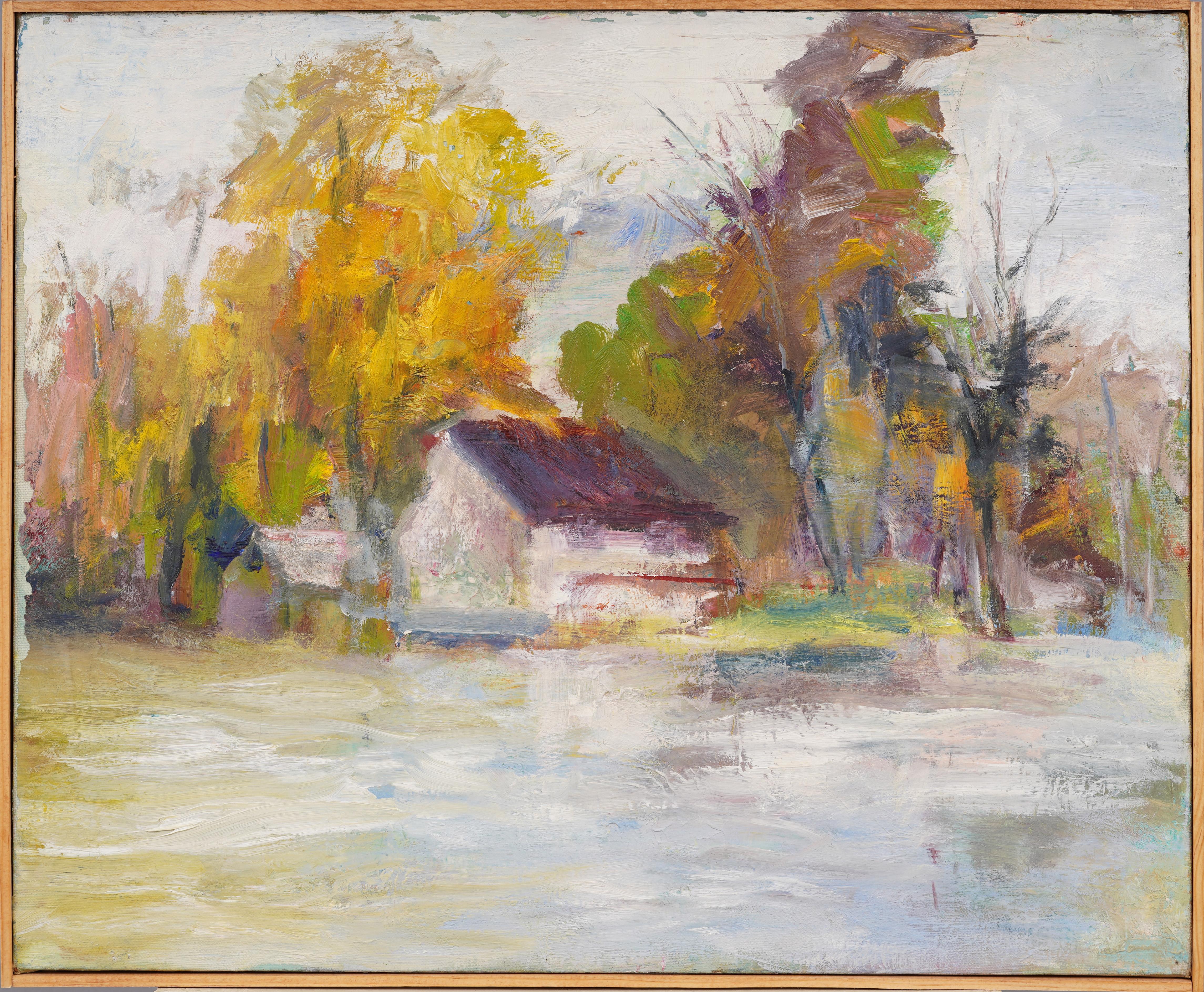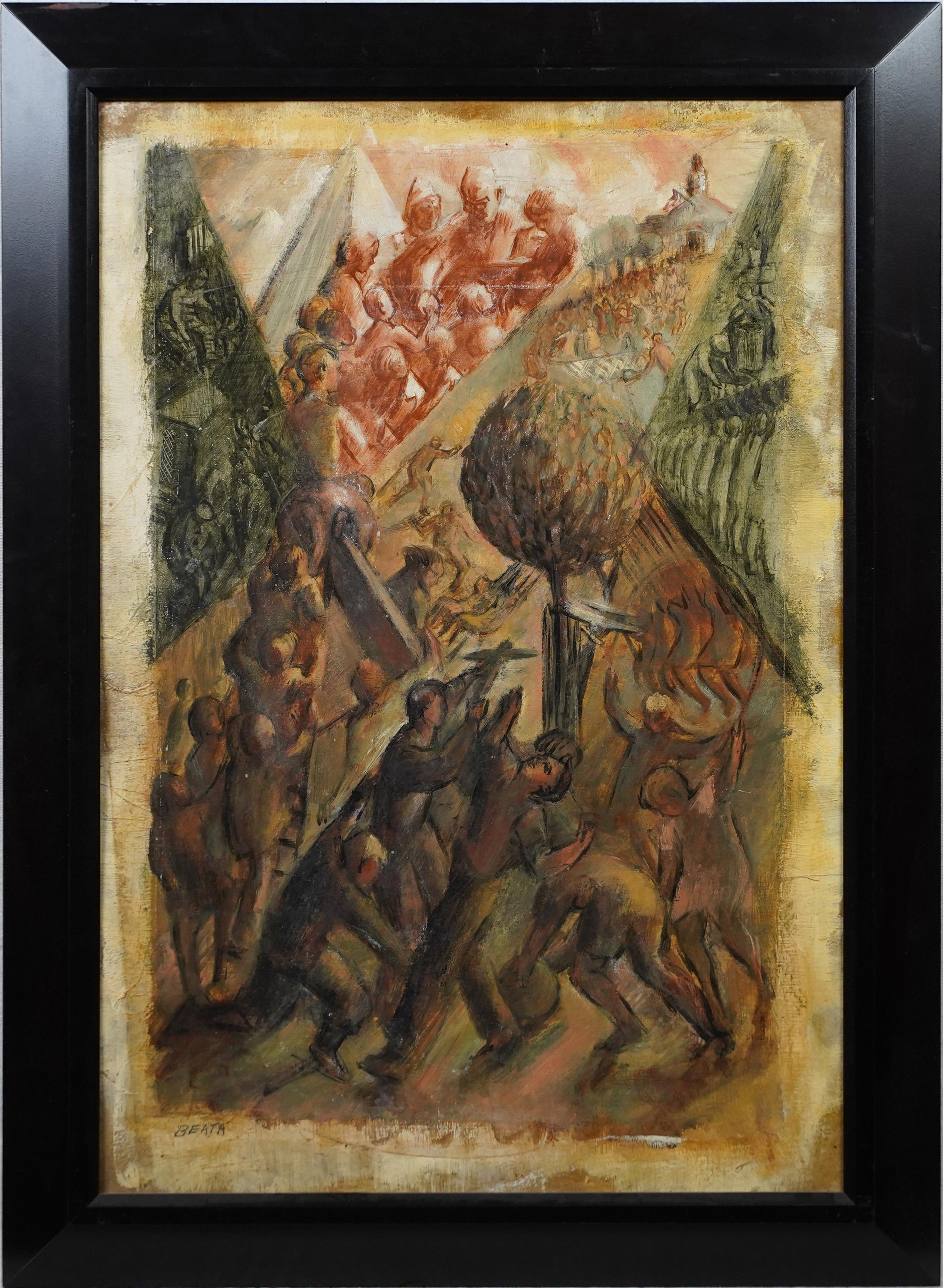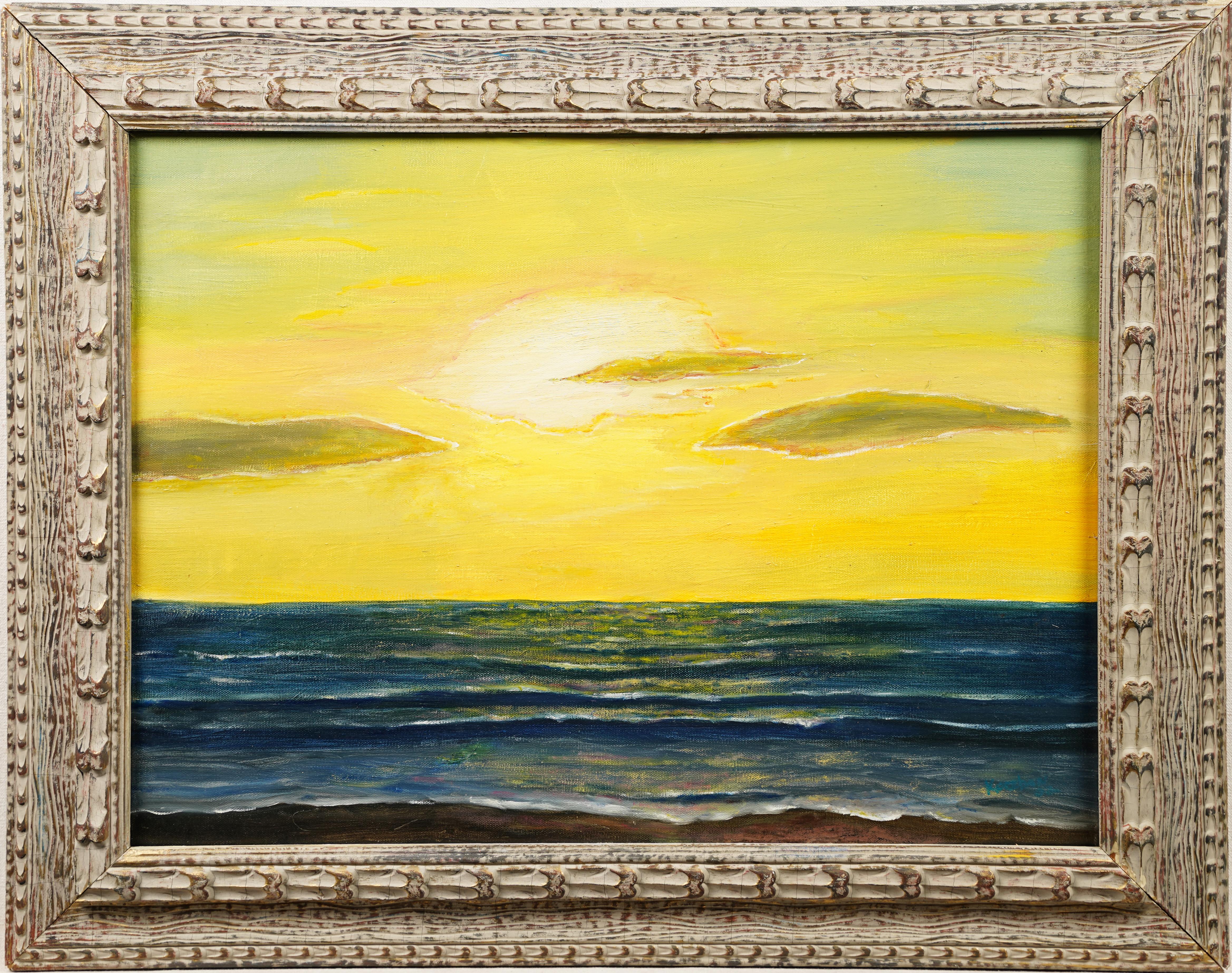Items Similar to Abstract Chiaroscuro Landscape, Oil on Canvas Painting by Francois Gentilini
Want more images or videos?
Request additional images or videos from the seller
1 of 20
Francois GentiliniAbstract Chiaroscuro Landscape, Oil on Canvas Painting by Francois Gentilini1976
1976
About the Item
This beautiful oil-on-canvas painting was created by Francois Gentilini (1930 -). This is a small-scale oil painting by the well-listed French Modern painter Francois Gentilini. The graphics are structured with geometric lines depicting abstract architecture. The painter has applied the traditional Chiaroscuro technique in a modern way to create a strikingly contemporary landscape. The painting's color palette features shades of dark greens and browns, with only the points of light on the canvas providing illumination. The tones are sustained, and the colors are vibrant.
A hand-written inscription at the back of the canvas reads Francois Gentilini - Les Mesneux Pres Reims - 51 - 1976.
Newly reframed in an elegant wood frame and off-white fabric jutte liner.
Measurements:
With frame: 12.19 in wide (31 cm) x 14.19 in high (36 cm).
Opening view: 7.07 in wide (18 cm) x 9.25 in high (23.5 cm).
The last three pictures show the canvas before reframing.
Note: Francois Gentilini is a French painter born in 1930. He studied at the College St Joseph in Reims, class of 1949. He was awarded an outstanding scholarship from the city of Reims in 1955 for his exceptional work on various projects undertaken for the town hall of Reims. He taught at the School of Fine Arts in Reims at the end of the 60s and the 70s. He is very appreciated by his students because he advocates respect for the freedom and personality of the artist, even if he is a budding artist. In 1986 the Galerie Winnie du Moriez in Reims devoted a retrospective exhibition of this painter from Reims.
Note: Chiaroscuro (Italian for 'light-dark'), in art, is the use of strong contrast between light and dark, usually bold contrasts affecting a whole composition. It is also a technical term used by artists and art historians using contrasts of light to achieve a sense of volume in modeling three-dimensional objects and figures. Similar effects in cinema with black and white and low-key photography are called chiaroscuro.
Chiaroscuro originated from the Renaissance period but is most notably associated with Baroque art. Chiaroscuro is one of the canonical painting modes of the Renaissance.
(Credit: Wikipedia)
- Creator:Francois Gentilini (1930, French)
- Creation Year:1976
- Dimensions:Height: 14.18 in (36 cm)Width: 12.21 in (31 cm)Depth: 1.78 in (4.5 cm)
- Medium:
- Movement & Style:
- Period:
- Condition:
- Gallery Location:Atlanta, GA
- Reference Number:
About the Seller
5.0
Vetted Seller
These experienced sellers undergo a comprehensive evaluation by our team of in-house experts.
1stDibs seller since 2019
67 sales on 1stDibs
Typical response time: 3 hours
- ShippingRetrieving quote...Ships From: Atlanta, GA
- Return PolicyThis item cannot be returned.
More From This SellerView All
- The Yellow Eiffel Tower, Oil on Canvas Painting by Claude-Max LochuLocated in Atlanta, GAThis oil on canvas painting is by French artist Claude-Max Lochu (1951 -) and features an iconic Paris view with a poetic vision of the Eiffel Tower in yellow and purple tones. The a...Category
1990s Modern Landscape Paintings
MaterialsCanvas, Oil
- Abstract Cityscape Cubist Oil on Canvas Painting by E. PullmanLocated in Atlanta, GAFrench artist E. Pullman (France, 20th Century) designed this stylish cubist abstract cityscape oil on canvas painting. The skillful composition and rigorous construction use vivid c...Category
Late 20th Century Cubist Landscape Paintings
MaterialsOil, Canvas
- Pointillism Skyscrapers Cityscape Oil on Canvas Painting by Le BoreuxLocated in Atlanta, GAThis interesting Mid Century Modern abstract pointillist cityscape oil on canvas painting is by Le Boreux (France, 20th Century). It depicts a colorful and vibrant brutalist cityscap...Category
Mid-20th Century Pointillist Landscape Paintings
MaterialsCanvas, Oil
- By the Beach, Oil on Canvas Painting by André HambourgBy André HambourgLocated in Atlanta, GAThis elegant oil on mounted canvas is by André Hambourg (France, 1909-1999) and features a seaside composition. The artwork is signed in the bottom left corner. The landscape is a lovely pastel color composition, by the beach, on the French Atlantic coast nearby Cabourg or Deauville. Newly framed with a gray and green ceruse wood frame and a blue canvas matte. Measurements: With frame: 22.82 in. wide (58 cm) x 19.32 in. high (49 cm). Opening: 16.13 in. wide (41 cm) x 12.63 in. high (32 cm). About: André Hambourg was born in Paris on 5 May 1909. Entering the Ecole Nationale Superieure des Arts Decoratifs in 1926, he studied sculpture under Paul Niclausse for four years. The young artist then entered the studio of Lucien Simon at the Ecole Nationale Superieure des Beaux-Arts. While in the middle of his academic studies, Hambourg had his debut solo exhibition at the Galerie Taureau in Paris in 1928. He was only 19 years old. Because of the early recognition of his talent, Hambourg became active in major Paris salons in the first stages of his fledgling career. In 1931, he was made a member of the Salon de l’Art Français Indépendant and the Salon de l’Oeuvre Unique. The first of Hambourg’s many honors was the Prix de la Villa Abd-el-Tif, awarded in 1933. As a result, the artist traveled to North Africa for the first time and spent nearly ten years working in Algeria and Morocco. The strong light of the sun, and the bleak poverty of this region, inspired Hambourg’s works. In 1937, he executed a large mural for the Algerian Pavilion at the Exposition Internationale of Paris. Throughout his years in North Africa, Hambourg would exhibit his paintings in numerous solo exhibitions in Algeria and Paris. In 1939, Hambourg was mobilized as a military reporter and draughtsman and worked on the staff of the Journal de Commissariat a la Guerre, the newspaper of the French army, under the pseudonym Andre Hache. Special missions on combat vessels led to his appointment as a war correspondent in 1944 with the staff of inter-allied SHAEF. As such, he participated in the campaigns of Germany, Alsace, the Atlantic front, and the Liberation of France. After returning to his artistic career for a short time, Hambourg became the official painter of the Navy in 1952. He undertook numerous voyages aboard French Navy vessels on missions worldwide, including Venice, the Soviet Union, Israel, Great Britain, The Ivory Coast, The United States, and Mexico. From these extended trips, the artist brought back numerous sketches and preparatory drawings for future paintings and illustrations. His international trips would have a lasting influence on his artwork. Hambourg’s adventurous maritime career resulted in his receiving the honor of Laureate of the Salon de la Marine and becoming the official painter of the Marine Ministry. In 1970, five hundred of his works created a prestigious retrospective at the Maison de Culture in Bourges, France. Other notable shows include Drawings of Venice...Category
1950s Post-Impressionist Landscape Paintings
MaterialsCanvas, Oil, Board
- Post-Cubist Abstract Oil on Canvas Painting by HellierLocated in Atlanta, GAAmerican artist Hellier (20th Century) designed this stunning post-cubist constructivist oil on canvas painting. This painting named "Ste Augustine" features a skillful composition a...Category
1950s Cubist Landscape Paintings
MaterialsCanvas, Oil
- The Blue Trees, Oil on Canvas Painting by Claude Richard MazierLocated in Atlanta, GAThis pretty oil on canvas modernist composition, typical of the 1950s, features a house in a village in the countryside with imaginary blue trees, designed by Claude Richard Mazier (...Category
1950s Modern Landscape Paintings
MaterialsCanvas, Oil
You May Also Like
- Amish Farmscape #3By Edmund LewandowskiLocated in Los Angeles, CAAmish Farmscape #3, 1984, oil on canvas, 40 x 30 inches, signed and dated lower right; signed, dated, and titled verso About the Painting Amish Farmscape #3 is part of a multi-painting series of barns completed in the early 1980s for an exhibition at New York’s prestigious Sid Deutsch Gallery. Lewandowski painted this work at an important point in his career. It was the first major project undertaken by Lewandowski after his retirement from serving as the Chairman of Winthrop University’s Art Department, the last academic position he held after teaching for nearly thirty years. Lewandowski had been inspired to work on the series by a visit to Lancaster County, Pennsylvania. Like his friend and mentor, Charles Sheeler, Lewandowski had always been fascinated by vernacular architecture and the Amish barns of Pennsylvania brought back memories of rural scenes Lewandowski had painted in the Midwest much earlier in his career. Amish Farmscape #3 is a strong example of Lewandowski’s late precisionist work. The complexity of the composition and Lewandowski’s technical acumen are on full display. Being relieved of the burdens of teaching and administering a university art department likely allowed Lewandowski greater freedom and most importantly more time to complete the Amish Farmscape series. Although Lewandowski’s brand of precisionism changed throughout the years, he never deviated from the core tenets of the Immaculate School artists. In this work, we see simplified and flattened forms, the use of ray-lines to define light and space, the elimination of extraneous details, a polished almost machine-like finish, and the complete lack of visible brushstrokes, all hallmarks of the precisionist painters. Lewandowski was the last of the 20th century precisionists and in Amish Farmscape #3, we see just how successfully he continued to work in this style until his death in 1998. About the Artist Edmund Lewandowski was among the best of the second-generation precisionist painters. He was born and raised in Milwaukee, Wisconsin and studied at the Layton School of Art with Garrett Sinclair. Lewandowski achieved early success when in 1936 two of his watercolors were shown at the Phillips Collection as part of a Federal Art Project exhibition. Then, in 1937, his work was first exhibited at Edith Halpert’s Downtown Gallery which represented Lewandowski into the 1950s. Under Halpert’s guidance, Lewandowski continued to explore watercolor as his main medium during the 1930s and 1940s, since the gallery already represented Charles Sheeler, who worked primarily in oils. Sheeler became Lewandowski’s major influence as the primary leader of the ill-defined, but very recognizable Immaculate School artists, which included other Downtown Gallery painters, Niles Spencer, George Ault, and Ralston Crawford, as well as Charles Demuth and Preston Dickinson, both of whom died at a young age and had been represented by the Charles Daniel Gallery. Sheeler is credited with giving Lewandowski technical advice on how to make his paintings more precise and tightly rendered and by all accounts, Sheeler was a fan of Lewandowski’s work. Through the Downtown Gallery, Lewandowski’s paintings were accepted into major national and international exhibitions and purchased by significant museums and collectors. Franklin and Eleanor Roosevelt and Nelson Rockefeller acquired works by Lewandowski. He was included in the Museum of Modern Art’s important 1943 exhibition, American Realists and Magic Realists as well as juried exhibitions at the Whitney Museum of American Art, the Pennsylvania Academy of Fine Arts, and the Art Institute of Chicago. Lewandowski also completed commissions for magazines during the 1940s and 1950s, including several covers for Fortune. Throughout his career, Lewandowski explored urban and rural architecture, industry, machinery, and nautical themes. Looking back on his career, Lewandowski wrote, “My overwhelming desire as an artist through the years has been to record the beauty of man-made objects and energy of American industry on canvas. For as far back as I can recall, the cityscapes, farms and depictions of industrial power and technological efficiency has had a great attraction for me. I try to treat these observations with personal honesty and distill these impressions to a visual order.” Lewandowski is credited with extending precisionism to the Midwest and successfully continuing the style into the 1990s, three decades after Sheeler’s death and six decades after Demuth’s passing. Late in his career, Lewandowski enjoyed a resurgence of popularity as he was represented during the 1980s by New York’s Sid Deutsch and Allison Galleries...Category
Mid-20th Century American Modern Landscape Paintings
MaterialsCanvas, Oil
- Lake Oil on canvas, 50x71 cmLocated in Riga, LVLake Oil on canvas, 50x71 cm Lidija Auza (1914. 24. 02 Vitebsk, Belarus – 1989. 13. 12 Riga, Latvia) Painter She studied at the Art Academy of Latvia (1936-1938) and graduated ...Category
Late 20th Century Modern Landscape Paintings
MaterialsCanvas, Oil
- Antique American School Modernist Landscape Framed Mid Century Oil PaintingLocated in Buffalo, NYOil on canvas. Framed.Category
1940s Modern Abstract Paintings
MaterialsCanvas, Oil
- Antique American School Modernist Framed Signed Exhibited Abstract Oil PaintingLocated in Buffalo, NYOil on board. Framed. Signed. Exhibited at the Butler Art Institute.Category
1940s Modern Abstract Paintings
MaterialsCanvas, Oil
- American School Modernist Framed Original Sunset Signed Seascape Oil PaintingLocated in Buffalo, NYAntique American modernist signed seascape oil painting. Oil on canvas. Signed. Framed.Category
1940s Modern Landscape Paintings
MaterialsCanvas, Oil
- Antique American Modernist WPA Mural Study Signed Framed Original Oil PaintingLocated in Buffalo, NYAntique American modernist signed mural study oil painting. Oil on board. Signed. Framed.Category
1920s Modern Landscape Paintings
MaterialsCanvas, Oil




